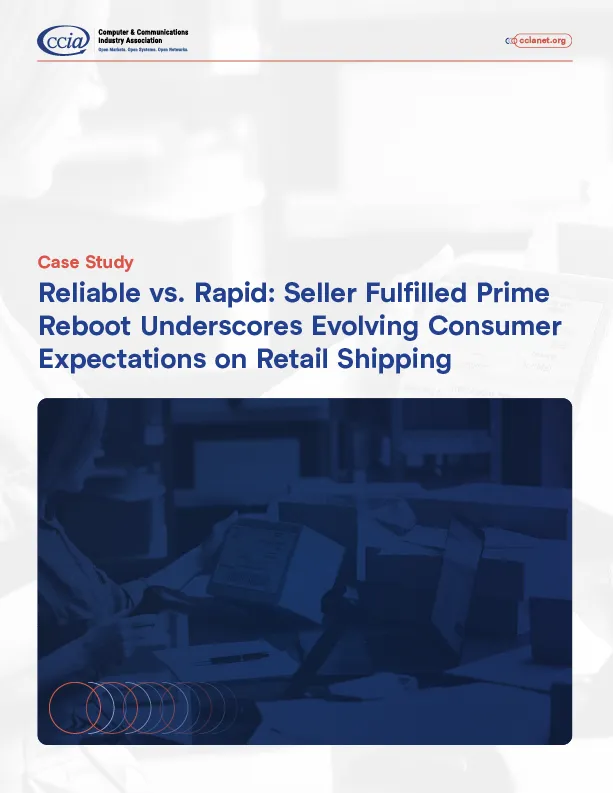Executive Summary
The history of Amazon’s Seller Fulfilled Prime (“SFP”) provides strong evidence of the growing importance that consumers place on speed in retail shopping. Launched in 2015 to help sellers on Amazon’s marketplace offer Prime-badged goods to customers, sellers participating in SFP have long struggled to meet consumer expectations. Amazon repeatedly raised the program’s standards in efforts to meet Prime customers’ demands, and redesigned SFP’s requirements multiple times. Nevertheless, the program consistently underperformed, delivering significantly slower than Amazon’s in-house logistics. Around 2018, less than 16% of SFP offers were meeting the Prime delivery promise of 2 days or less.
While sellers participating in SFP reliably met their own estimated delivery times, those times were longer than what Prime customers expected. Federal Trade Commission officials have recently confused shipping reliability with shipping speed, however, reflecting a misunderstanding of what retail consumers want. Retail consumers do not simply want packages to arrive on time; they increasingly insist on actual two-day delivery (or even faster), and retailers unable to fulfill that expectation can expect to be left behind.
Evolving logistics to meet consumer expectations
Amazon has invested over $100 billion in its fulfillment and delivery network to get products to customers. In 2006, it opened its proprietary network up to third party sellers on its marketplace with the Fulfillment by Amazon (FBA) program, which gave sellers an option to outsource their fulfillment, delivery, customer service, and returns to Amazon.
Beyond just building warehouses to store products, Amazon invested in logistics capabilities to get goods to customers’ doors. While Amazon once relied heavily on FedEx and UPS to deliver packages, it experienced poor performance with delivery speeds in the 2013 holiday season. An unexpected number of late arrivals that Christmas created a customer service nightmare. Amazon had just started delivering on Sundays through USPS; it now had an additional need to invest in the sortation and delivery of products because commercial carriers simply weren’t investing to improve speed, performance, and nationwide capacity at the rate Amazon and its customers required. Amazon thus began building out its own delivery network. Starting from seven U.S. fulfillment centers in 2004, Amazon had 253 fulfillment centers, 110 sortation centers, and 467 delivery stations in North America by the end of 2021, and its delivery network had more than 260,000 drivers worldwide.
These logistics investments substantially increased delivery speed and reliability. In 2015, Statista estimated that Amazon purchases averaged a click-to-door speed of 5.92 days across all purchases. In 2022, eMarketer estimated that same speed was just 1.9 days, more than twice as fast as the retail average, and that was on track to improve further in 2023.
In 2015, Statista estimated Amazon purchases averaged a click-to-door speed of 5.92 days. In 2022, eMarketer estimated that speed was just 1.9 days, more than twice the retail average
For Consumers, “Reliable” Delivery < Actual Two-Day < Actual Same-Day
These logistics investments occurred against the backdrop of a rapidly growing consumer preference for speed across all retail channels. A 2022 study found, for example, that nearly half of consumers prefer same-day in-store pick up 5 minutes away over a two-day wait. Polls conducted by McKinsey found that almost half of respondents abandoned online carts due to long shipping times: “shopping decisions increasingly depend on shipping times.” This McKinsey takeaway was reinforced by findings from a Deloitte study that consumers would pay premiums for Same Day/Next Day delivery relative to Two-Day delivery, and would increasingly abandon shopping online as delivery times exceeded two days, particularly as delivery times approached or exceeded one week. Consumers are always evaluating actual fulfillment times when making decisions between retailers and between retail channels like online, omnichannel, and brick and mortar. When fulfillment times slow down in one channel or for one retailer, consumers are quick to make a switch.

From the Deloitte paper Consumer Preferences Embrace a Mix of Physical and Digital

From the Deloitte paper Consumer Preferences Embrace a Mix of Physical and Digital
Similarly, a 2023 study based on a large survey of consumers found that consumers value free two-day delivery as a component of retail memberships, and also place a significant positive value on other rapid fulfillment options like buy online, pick up in store or curbside pickup. Consumers similarly valued proximity for brick and mortar stores and stores offering BOPIS or curbside pickup, showing that fulfillment speed can matter even on a timespan minutes and hours. The emerging consensus in retail industry research is that consumers value actual fulfillment speed, and faster fulfillment is a major driver of consumer choice.
These developments have spurred innovation across the industry toward getting goods to consumers faster. Nationwide, retailers have increased their speed, as customers’ expectations from all shippers have risen based on their experience with Amazon. Across the retail sector, executives now regard same-day delivery as a high priority, and 99% of retailers plan to offer it by 2025.
Today, the Amazon fulfillment network delivers hundreds of millions of items to customers in two days, many of the most popular items in one day or less. In major cities, it delivers several million items in as little as 5 hours, and possibly as fast as 22 minutes.
History of Seller Fulfilled Prime
Amazon started Seller Fulfilled Prime in 2015 to boost the selection of products available to customers at Prime speeds by building a mechanism for 3P sellers who do not use Amazon’s fulfillment network to provide Prime-branded offers to customers.. Amazon CEO Jeff Bezos wrote to shareholders that the SFP program helped to make hundreds of thousands of new items available to Prime customers.
Yet the SFP program long had issues with sellers not consistently meeting the Prime standard. Crucially, the initial iteration of the program did not include a specific requirement for speed. Instead, sellers were required to: (1) ship 99% of items ordered before 2pm that same business day; and, (2) use Amazon’s “Buy Shipping” service for 95% of orders, which curated carriers that could reliably delivery in 2 days, often for a discount. For example, the Amazon Buy Shipping rate for USPS Ground is approximately 35% cheaper than the standard rate.
Because SFP imposed no requirements to deliver products within 2 days of being ordered, the majority of SFP shipping wasn’t. For example, orders might be received on Friday and handed off to a carrier on Monday for 2-day delivery, or shipped on Thursday via a carrier with no weekend delivery, thus arriving 5 days after placement, three days longer than the expected Prime 2-day experience. In fact, under these standards in 2018 fewer than 16% of SFP offered the actual 2-day delivery standard that Prime customers had come to expect.
In 2018 fewer than 16% of SFP offered the actual 2-day delivery standard that Prime customers had come to expect.
SFP sellers were delivering reliably, just not rapidly. In short, the metric for SFP did meet Prime consumers’ expectations: SFP shippers were using two-day shipping services, but largely not making actual delivery in two days.
This fact is regularly misunderstood. Speaking about the U.S. Federal Trade Commission’s case against Amazon, federal officials have stated that Amazon “[s]ellers enrolled in SFP met their promised “delivery estimate” requirement set by Amazon more than 95% of the time in 2018.” But reliability is not the same as speed, which consumers had come to expect. In fact, agency officials have consistently conflated these two metrics, with FTC Chair Lina Khan stating incorrectly that in 2018 “sellers were effectively meeting the same standards that FBA does.” SFP sellers were not meeting the same speed standards that Prime customers expected, however. Due to latency in seller fulfillment, the Prime two-day commitment was going unfulfilled, and consumers weren’t pleased.
In February 2019, Amazon paused the SFP program to work with sellers, and announced changes in 2020 to address the fact that many sellers do not operate on weekends. It relaunched the program in 2023 with a focus on actually meeting the two-day commitment.
SFP Rebooted
The SFP program now places benchmarks on actual delivery speed:
- Speed for a standard-sized package—30% of orders must be delivered within 1 calendar day and 70% within 2 calendar days of being placed. By shifting from the requirement of using a 2-day shipping service to requiring 2-day delivery, the SFP program now factors in the time required to package and ship a product.
- Same day shipping—Orders received before 2pm on weekdays and 10:30am on weekends must be shipped the same day.
- Reliability—An “On-Time Delivery” rate of 93.5%. By making delivery time an express metric, SFP sellers are incentivized to choose carriers that can actually deliver on the Prime commitment.
The reboot of SFP illustrates the increased pressure of retail consumer demands about shipping, which is not just reliability, but rapidity as well. Reliability goes without saying, of course, but regulators are mistaken in conflating reliably meeting promised delivery times with actual speed. A “new normal” has been set for actual expedited delivery—not just the use of expedited service—and consumers’ decisions increasingly turn on it.




